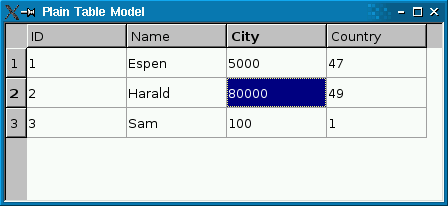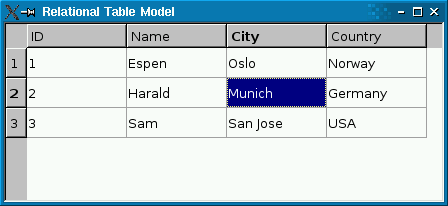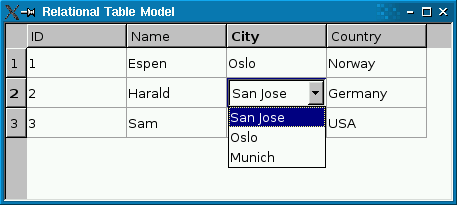QSqlRelationalTableModel Class Reference |
 |  |
The screenshot on the left shows a plain QSqlTableModel in a QTableView. Foreign keys (city and country) aren't resolved to human-readable values. The screenshot on the right shows a QSqlRelationalTableModel, with foreign keys resolved into human-readable text strings.
The following code snippet shows how the QSqlRelationalTableModel was set up:
model->setTable("employee");
model->setRelation(2, QSqlRelation("city", "id", "name"));
model->setRelation(3, QSqlRelation("country", "id", "name"));
The setRelation() function calls establish a relationship between two tables. The first call specifies that column 2 in table employee is a foreign key that maps with field id of table city, and that the view should present the city's name field to the user. The second call does something similar with column 3.
If you use a read-write QSqlRelationalTableModel, you probably want to use QSqlRelationalDelegate on the view. Unlike the default delegate, QSqlRelationalDelegate provides a combobox for fields that are foreign keys into other tables. To use the class, simply call QAbstractItemView::setItemDelegate() on the view with an instance of QSqlRelationalDelegate:
QTableView *view = new QTableView;
view->setModel(model);
view->setItemDelegate(new QSqlRelationalDelegate(view));
The sql/relationaltablemodel example illustrates how to use QSqlRelationalTableModel in conjunction with QSqlRelationalDelegate to provide tables with foreigh key support.

Notes:
- The table's primary key may not contain a relation to another table.
- If a relational table contains keys that refer to non-existent rows in the referenced table, the rows containing the invalid keys will not be exposed through the model. The user or the database is responsible for keeping referential integrity.
See also QSqlRelation and QSqlRelationalDelegate.
Member Function Documentation
QSqlRelationalTableModel::QSqlRelationalTableModel ( QObject * parent = 0, QSqlDatabase db = QSqlDatabase() )
Creates an empty QSqlRelationalTableModel and sets the parent to parent and the database connection to db. If db is not valid, the default database connection will be used.
QSqlRelationalTableModel::~QSqlRelationalTableModel () [virtual]
Destroys the object and frees any allocated resources.
QSqlRelation QSqlRelationalTableModel::relation ( int column ) const
Returns the relation for the column column, or an invalid relation if no relation is set.
See also setRelation() and QSqlRelation::isValid().
QSqlTableModel * QSqlRelationalTableModel::relationModel ( int column ) const [virtual]
Returns a QSqlTableModel object for accessing the table for which column is a foreign key, or 0 if there is no relation for the given column.
The returned object is owned by the QSqlRelationalTableModel.
See also setRelation() and relation().
bool QSqlRelationalTableModel::setData ( const QModelIndex & index, const QVariant & value, int role = Qt::EditRole ) [virtual]
Sets the data for the role in the item with the specified index to the value given. Depending on the edit strategy, the value might be applied to the database at once, or it may be cached in the model.
Returns true if the value could be set, or false on error (for example, if index is out of bounds).
For relational columns, value must be the index, not the display value.
Reimplemented from QAbstractItemModel.
See also editStrategy(), data(), submit(), and revertRow().
void QSqlRelationalTableModel::setRelation ( int column, const QSqlRelation & relation ) [virtual]
Lets the specified column be a foreign index specified by relation.
Example:
model->setTable("employee");
model->setRelation(2, QSqlRelation("city", "id", "name"));
The setRelation() call specifies that column 2 in table employee is a foreign key that maps with field id of table city, and that the view should present the city's name field to the user.
Note: The table's primary key may not contain a relation to another table.
See also relation().
Best Of
Actualités les plus lues
- Les développeurs détestent-ils les antivirus ? Un programmeur manifeste sa haine envers ces solutions de sécurité 6
- Une nouvelle ère d'IHM 3D pour les automobiles, un concept proposé par Digia et implémenté avec Qt 2
- PySide devient un add-on Qt et rejoint le Qt Project et le modèle d'open gouvernance 1
- Qt Creator 2.5 est sorti en beta, l'EDI supporte maintenant plus de fonctionnalités de C++11 2
- Implémentation d'une table de hachage à référence faible avec Qt, un article de Christophe Dumez traduit par Thibaut Cuvelier 4
- Vingt sociétés montrent leurs décodeurs basés sur Qt au IPTV World Forum, en en exploitant diverses facettes (déclaratif, Web, widgets) 0
- « Quelque chose ne va vraiment pas avec les développeurs "modernes" », un développeur à "l'ancienne" critique la multiplication des bibliothèques 94
- Apercevoir la troisième dimension ou l'utilisation multithreadée d'OpenGL dans Qt, un article des Qt Quarterly traduit par Guillaume Belz 0
- Pourquoi les programmeurs sont-ils moins payés que les gestionnaires de programmes ? Manquent-ils de pouvoir de négociation ? 45
- Les développeurs ignorent-ils trop les failles découvertes dans leur code ? Prenez-vous en compte les remarques des autres ? 17
- Les développeurs détestent-ils les antivirus ? Un programmeur manifeste sa haine envers ces solutions de sécurité 6
- Quelles nouveautés de C++11 Visual C++ doit-il rapidement intégrer ? Donnez-nous votre avis 10
- Qt Commercial : Digia organise un webinar gratuit le 27 mars sur la conception d'interfaces utilisateur et d'applications avec le framework 0

- Linus Torvalds : le "C++ est un langage horrible", en justifiant le choix du C pour le système de gestion de version Git 100
- Comment prendre en compte l'utilisateur dans vos applications ? Pour un développeur, « 90 % des utilisateurs sont des idiots » 229
- Quel est LE livre que tout développeur doit lire absolument ? Celui qui vous a le plus marqué et inspiré 96
- Apple cède et s'engage à payer des droits à Nokia, le conflit des brevets entre les deux firmes s'achève 158
- Nokia porte à nouveau plainte contre Apple pour violation de sept nouveaux brevets 158
- Quel est le code dont vous êtes le plus fier ? Pourquoi l'avez-vous écrit ? Et pourquoi vous a-t-il donné autant de satisfaction ? 83
- Le Draft final de la norme C++ 0X validé 181

Le Qt Developer Network au hasard

QML et les styles
Communauté
Ressources
- 91 cours et tutoriels Qt
- F.A.Q. Qt : 200 questions et réponses
- 48 Qt Quarterly, 35 Qt Labs et 22 Qt DevNet en français
- 43 outils Qt
- 99 sources Qt
- 26 binaires Qt
- 6 livres Qt et 9 critiques
- La documentation de Qt 4.7 en français : 157 classes, 70 concepts et 24 modules
- 3 certifications Qt
Liens utiles
Contact
- Vous souhaitez rejoindre la rédaction ou proposer un tutoriel, une traduction, une question... ? Postez dans le forum Contribuez ou contactez-nous par MP ou par email (voir en bas de page).
Qt dans le magazine
| Cette page est une traduction d'une page de la documentation de Qt, écrite par Nokia Corporation and/or its subsidiary(-ies). Les éventuels problèmes résultant d'une mauvaise traduction ne sont pas imputables à Nokia. | Qt 4.1 | |
| Copyright © 2012 Developpez LLC. Tous droits réservés Developpez LLC. Aucune reproduction, même partielle, ne peut être faite de ce site et de l'ensemble de son contenu : textes, documents et images sans l'autorisation expresse de Developpez LLC. Sinon, vous encourez selon la loi jusqu'à 3 ans de prison et jusqu'à 300 000 E de dommages et intérêts. Cette page est déposée à la SACD. | ||
| Vous avez déniché une erreur ? Un bug ? Une redirection cassée ? Ou tout autre problème, quel qu'il soit ? Ou bien vous désirez participer à ce projet de traduction ? N'hésitez pas à nous contacter ou par MP ! | ||
Copyright © 2000-2012 - www.developpez.com



















